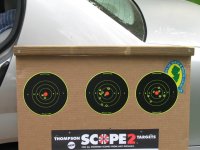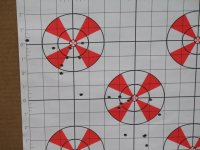Connnie, I can tell you are having fun. Good!
First suggestion: Do your Uncle a big favor and trade him the Tasco for his Leupold!

Shot some 22rf yesterday with a friend who held (may still hold) the record with his 6mmPPC. We both had Anshultz rifles of diffrent models. His new scope is a big Tasco! He was making one small ragged hole at 50 yds.
Try the heavier bullets. You never know, even with rifles of same make and same twist. But, in general, yes, you need a tighter twist for the heavier bullet. Another BUT, bullets vary in ogive, length and bearing in the bbl. Just gotta try it. Some heavier bullets may stabilize while another of the same weight may not.
Here is what I use but do not take it as a recommendation or gospel because you have to feed your rifle what it likes ...
222 - H322 23g, 52-53g bullet, standard primer, most any brass that is free!

223 - H322 25g, 55g Sierra Blitz bullet, standard primer
22-250 - H322 32g or IMR3031 34g, 55g bullet
220Swift -3031 33.5g or 4064 38g, 55g bullet
I bought a supply of SX and Blitz bullets years ago - like 25 - but assume thery are still available.
Every rifle is a challenge unto itself! Except I have never met a 30-06 that did not like 58g or H4831 behind any bullet you can stuff in! I use H4831 in all the 30-06 cases - 25-06, 270, 280 (7mm Express) and 30-06. Also in 7MMM, 300 WM and 338WM.
I could live with just H322 and H4831. Well, need something for my handguns and shotguns, too. So, add at least Bullseye or Red Dot.
Now, since your thread is popular I will throw out soemthing to get folks rolling their eyes.
I have found that bullets have 'velocity accuracy ranges'. At around 2800-2850 fps
most bullets have an accuracy slot. Then they open until pushed to about 3150-3250 fps. Above that they start to open up again. I don't mean drastic changes but I was a benchrester for years and just found this to be true. There a bullet base width lost the match at times.
Finally, you can watch the bullet in flight and see its stabilty to compare one with another. Set a spotting scope up behind the shooter and focus at mid-range. What you can see is the bullet's shock wave in the air (unless you live in the desert where you may not). Occasionally you will see the bullet as a black dot. In a slow bullet like 22rf, or even a 30-30, you can see this with the naked eye under the right conditions. It is rare for me but I have known people who routinely see 22rf bullets in flight. A shooter who was older than I am now told me this in the mid-70's (Watch you bullet! It is going wild!). He had been a Camp Perry shooter and I have never found him to be wrong. He really taught me to shoot. You will wonder how you ever hit anything when you watch the path!
Enjoy!


